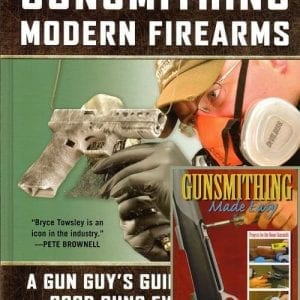 I am not one to jump on board gun-writing bandwagons, particularly those I know are wrong. For example, I was under incredible pressure from manufacturers and editors to endorse the 45-caliber muzzle loader craze several years ago. But the numbers didn’t impress me and I resisted. I did have an editor who, while he didn’t agree with me, gave me some latitude. I did the tests, ran the numbers, shot some deer and wrote an article that was critical. You may remember that it was Knight Rifles that launched that fad and Tony Knight was its strongest supporter. The first time I met Tony, I was standing in his office when his assistant handed him the newly printed magazine with that article. If you look up “awkward moment” in the dictionary, it will have a photo of me in Tony’s office. But it turns out I was right, and the 45-caliber guns have all but disappeared from the ML market.
I am not one to jump on board gun-writing bandwagons, particularly those I know are wrong. For example, I was under incredible pressure from manufacturers and editors to endorse the 45-caliber muzzle loader craze several years ago. But the numbers didn’t impress me and I resisted. I did have an editor who, while he didn’t agree with me, gave me some latitude. I did the tests, ran the numbers, shot some deer and wrote an article that was critical. You may remember that it was Knight Rifles that launched that fad and Tony Knight was its strongest supporter. The first time I met Tony, I was standing in his office when his assistant handed him the newly printed magazine with that article. If you look up “awkward moment” in the dictionary, it will have a photo of me in Tony’s office. But it turns out I was right, and the 45-caliber guns have all but disappeared from the ML market.
I am the same way about the current fad of shooting hogs with AR-15 rifles chambered for .223 Remington or .300 Blackout. It’s getting a lot of attention lately, but I am not on board. I know hog hunting pretty well and I know both those cartridges and their performance very well. I was working with the .300 Blackout back when J.D. Jones first developed it as the .300 Whisper about twenty years ago. I have shot it extensively at the range and on game. I have shot a lot of game with the .223 over the years as well. I have tested both extensively at the range, including shooting into ballistic medium. I don’t think the .223 Remington or the .300 Blackout are hog cartridges. Yes, they can kill hogs, but that does not make them “hog cartridges.” I know an old poacher who kills moose with a .22 LR, but that doesn’t make it a moose cartridge.
I was hog hunting before hog hunting was cool and have shot a lot of them with a lot of different cartridges. (Also several with a bow, a bunch with a knife and one we captured live that I carried out on my shoulder.) I have shot hogs with both of these cartridges and just have not been impressed. Yes, the new bullets help, but in the end the cartridges are too small.
One thing that is lost on many hunters is that not all hogs are created equal. If you are shooting sows and smaller hogs, say 150 pounds or less, which is about 90% of what hog hunters kill today, you are hunting a much different critter than a large, mature boar. A big boar is a tough customer with a thick shield of cartilage protecting his vital areas. That shield will rob bullet energy at an incredible rate. He is a virtual bullet trap and I have seen them stop bullets from very powerful firearms. These boars can grow very large and it’s not uncommon to be double the size of the best hogs most hunters are shooting. But double the size is not double the toughness, that grows exponentially and it’s a lot more. A big, battle scarred boar hog is one of the toughest critters in North America. They are mean, hard to kill and often dangerous. Most experienced hog guides have a big and nasty scar or two. I have seen hogs kill a dog in a blink of an eye and I have a buddy who came very close to dying after a boar attacked him. It broke his leg and cut the femoral artery. I have another buddy who ignored my advice about guns and cartridges and tried to shoot a big boar with a 9mm handgun. He was treed on a huge brushpile and in a state of panic when I arrived. The boar charged on sight and I killed him with a .44 Magnum handgun. These are not critters to be trifled with.
I never stop trying to learn, so I am constantly talking with hog hunters. Here is what I am getting from a lot of the newbie hunters promoting those small cartridges.
Most know very little about terminal ballistics and bullet performance. I can’t remember one ever telling me that they have spent any time tracing wound channels and recovering bullets.
“The hog died, so the cartridge worked,” is the sarcastic answer I encounter all too often. They brush off my questions about how many hogs run off wounded and are not recovered. “It’s just a hog, who cares,” is the most common response. For the record, I care. No game animal deserves to suffer.
Most say they are shooting for the head. Most any cartridge will work here. I once killed a large boar hog with a .17 HMR and a head shot, when I didn’t have a choice. He died, but trust me, the .17 HMR is not a hog cartridge.
Also for the record, I detest head shots on any animal. I think they are disrespectful and the odds of a wounding loss are very high. There is nothing worse than an animal starving to death because his bottom jaw is blown off. I do take them occasionally, but only if it’s the only option.
I feel strongly enough about this issue that I am working on an article for American Hunter Magazine on the best cartridges for hunting hogs with an AR-15 rifle. (Look for it later this year, as it covers a lot of other cartridges.)
I just returned from an interesting trip in Texas where I tested the .450 Bushmaster with some engineering samples of the new Remington Hog Hammer ammo featuring the 275-grain Barnes XPB Bullet with an advertised muzzle velocity of 2,175 ft/s.
I shot eight hogs, ranging from a large boar to a few eating-size pigs. I gotta say, the .450 Bushmaster is a true AR-15 hog hunting cartridge.
I have some prior experience with the cartridge using the softer cup and core bullets that were previously available in factory loads. They were great for deer, but a bit soft for tough stuff like big hogs. The Barnes XPB Bullets that Remington is loading in the Hog Hammer Ammo change all that.

The .223 Remington with a recovered bullet beside the .450 Bushmaster with a recovered Barnes bullet. It’s pretty clear which one makes a bigger hole!
The Barnes XPB Bullets expand to nearly double diameter and out of the nine hits all but one exited. I had to shoot largest boar a second time because I hit him too far back with a running shot the first time. The second bullet hit the shoulder and was lodged under the skin behind the opposite shoulder. All other bullets exited, as they should.
Another bandwagon I never jumped on was “leave the bullet in the animal and dump all the energy.” I prefer a bullet to exit with a lot of remaining energy. That way the wound channel is large right to the exit. If I can get a long, large, hole through any critter I don’t care how much bullet energy is “wasted” on the ground behind them.
Energy doesn’t kill big game animals, tissue damage does. That’s why I favor big, heavy bullets with plenty of power driving them for hunting hogs. AR-15 cartridges like the .450 Bushmaster with the new Hog Hunter ammo and Barnes XPB bullets are just about perfect.




